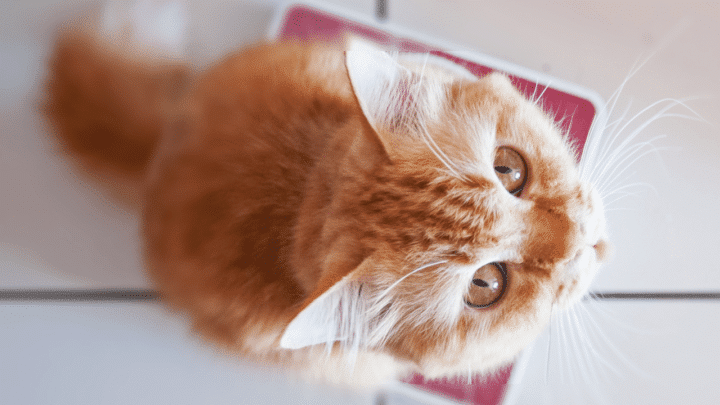If you’ve ever seen Garfield, chances are, you’ve also wondered if it’s okay for cats to eat that much lasagna. How much is too much for cats?
Unlike Garfield, real-life cats can’t talk—yeah, I know. I just ruined it for the kids—so we rely on other cues to assess our cats’ well-being.
You can get one of these cues by weighing your cat. A cat’s weight reveals a lot about its health, so it’s only right to strive for accuracy whenever we weigh cats.
That said, how exactly does one properly weigh a cat?
How to weigh a cat?
You can weigh your cat by using a cat carrier and a luggage scale, or you can weigh yourself with your cat. However, veterinary clinics have the appropriate scales and tools to weigh a cat, so it’s best to take your cat to the vet.
Weigh a cat using a luggage scale
In this method, you’ll want to position your cat carrier on the luggage scale with its entrance facing the ceiling.
Then, carefully pick up your cat with one hand under its bottom and another under its front legs.
Gently lower your cat (bottom first) into the carrier and close the door before correcting the carrier’s position. Record the weight reflected on the scale.
Next, you simply need to weigh the carrier without your cat. Record the weight reflected on the scale once again.
Once you have both weights, all you have to do is deduct the carrier’s weight from the combined weight of your cat and carrier to get the weight of your cat.
Weigh yourself with your cat
Another way to measure a cat’s weight is by weighing yourself while holding your cat.
This method is similar to weighing using a luggage scale, except instead of a cat carrier, you will be the one holding your cat.
Hold your cat comfortably in your arms, and step on your digital scale. Record the weight before letting your cat go.
Next, you’ll want to weigh yourself. The difference between you and your cat’s combined weight and your solo weight is your cat’s weight.
Consult your vet
The two ways mentioned above are the most common ways to weigh your cat. However, you still might want to consider consulting your vet for a more accurate result.
Veterinary clinics have the appropriate tools, such as cat scales for these purposes. So, it’s best to let the experts handle it.
Why should cats be weighed regularly?
A cat’s weight tells a whole lot about its health and well-being. In most cases, it serves as an indicator of some health issues, so it’s best practice to regularly check your cat’s weight just to make sure everything is okay.
In fact, a cat’s weight is one of the most invaluable data one can use to track a cat’s health status over time.
How much should cats weigh?
How much a cat should weigh depends on the age, breed, and form of the cat. Domestic cats usually weigh around 10 lbs (4.5 kg).
Naturally smaller cats like Siamese cats can only weigh around 5 lbs (2.3 kg). Larger cats like the Savannah cats are heavier, reaching up to 15 lbs (6.8 kg).
And like humans, cats also have different weight categories to assess their conditions connected with their weights.
Cat weight categories
Severely Underweight
A cat belongs to this category when its spine, pelvis, and ribs are clearly visible even from a distance.
In this case, the cat’s abdomen and underbelly are tucked up, indicating the lack of muscle mass and the absence of fat. A cat under this category also has a very prominent waistline.
Thin
Cats classified as thin have thin necks, little body fat. Its ribs, spine, and pelvis are also visible and can be felt.
Thin cats have no abdomen and underbelly, and when viewed from above, you can see their waistlines.
Ideal Weight
Cats with ideal weights are considered healthy cats. Their spine and ribs can be felt but may or may not be seen depending on the cat’s breed.
Healthy cats also have the right muscle mass with their underbellies visible from the sides. On top of that, these cats’ waistlines are clear and visible as well.
Overweight
Overweight cats have thick layers of overlying fat under their skins. This makes their spine and ribs invisible, but you can still feel them.
Their back legs also have large fat pads, and their chests and bellies are rounded. These cats have clearly visible underbellies which wobble when they move.
And when viewed from above, you can hardly see a waistline as there is little to no waistline.
Obese
Obese cats have very thick layers of overlying fat with noticeable fat visible around the face, lower back, and legs. They also have fat deposits on their tails.
With all the fat, their spine and ribs are not visible and can’t be felt. Their underbellies hang down and sway whenever these cats move.
When viewed from above, their backs also broaden.
Frequently Asked Questions About Cat Weights
Is it bad for my cat if I can feel her spine?
No, you should be able to feel your cat’s spine when you run your hand along your cat’s back. Being able to feel your cat’s spine indicates that your cat is healthy.
However, you should not be able to feel each vertebra as there should be enough muscle fat between your cat’s vertebrae and skin.
Can a cat be too skinny?
Yes, unnaturally skinny cats are severely underweight cats. They might not be eating enough due to the lack of food access, or they may be expending more energy than they are intaking.


